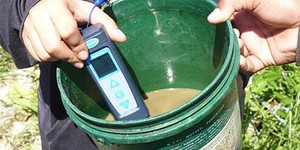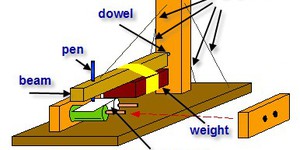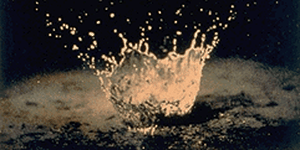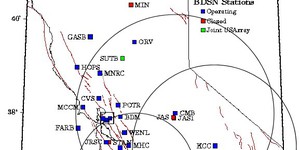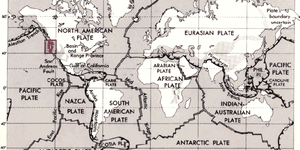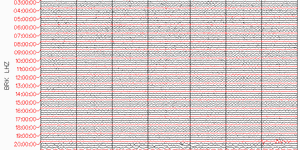Sixth Grade, Measure Something in Nature Science Projects (9 results)
Measure parts of the natural world like the brightness of the moon, the distance around the earth, or the rotation of the sun. Use science, math, or photography as you calculate the measurement.
|
Did you know that soils can be alkaline, neutral, or acidic? Most plants grow best in soil near neutral pH, but some plants prefer slightly acidic and others slightly alkaline soil. What is the pH of the soil in your garden? What happens to the pH of water that comes in contact with soil? In this science project you will get to find out.
Read more
Featured
Have you heard that garlic powder is supposed to inhibit the growth of bacteria? Which do you think would make a better disinfectant: a solution of garlic powder or a solution of bleach? This project shows you a straightforward way to compare the effectiveness of different disinfectants (or other antimicrobial agents), by measuring zones of inhibition on a culture plate.
Read more
You can measure the diameter of the Sun (and Moon) with a pinhole and a ruler! All you need to know is some simple geometry and the average distance between the Earth and Sun (or Moon). An easy way to make a pinhole is to cut a square hole (2-3 cm across) in the center of a piece of cardboard. Carefully tape a piece of aluminum foil flat over the hole. Use a sharp pin or needle to poke a tiny hole in the center of the foil. Use the pinhole to project an image of the Sun onto a wall or piece…
Read more
New
Engineers are trying to tackle the world's ocean pollution problem using robots. Some robots, like Mr. Trash Wheel and the ship featured in this Mark Rober video, are stationary and collect trash as it flows out of rivers before it gets into the ocean. Others, like the Jellyfishbot, are mobile and can squeeze into narrower spaces to collect trash:
Can you build and test your own trash-skimming robot? If you do not have access to a natural body of water to test it in, you can use a bathtub or a…
Read more
If you live in an area where earthquakes happen, you might be especially interested in this science project. You will learn how to build your own seismograph and how to use it to detect ground motion.
Read more
When you think of environmental challenges facing the world, the first things that come to mind might be global warming, or loss of biodiversity, since these are often in the newspapers. A serious problem that you may not have heard about is soil erosion. Why is soil so important? What is the danger of erosion? How can we measure soil erosion? What can be done to prevent it? Check out this project and you can start finding answers.
Read more
When an earthquake happens, how are scientists able to determine the original location of the quake? In this project, you'll use archived data from a network of seismometers to find out for yourself. You'll create your own seismograms from the comfort of your own computer with an easy-to-use webpage interface. Then you'll analyze your seismograms to determine the distance of the quake from each seismometer station. By mapping your analyzed data, you will be able to determine the location of the…
Read more
New
Artificial intelligence (AI) programs can now generate photorealistic pictures of people who do not exist in the real world. How can you tell if a picture is of a real person or a fake, AI-generated person? What features of the picture do people use to decide whether the face is real or AI-generated? In this project, you will explore these questions as you ask volunteers to look at both real and AI-generated pictures of human faces.
Read more
The Ring of Fire is a region of volcanic and earthquake activity that surrounds the Pacific Ocean. In this project you can explore the connection between plate tectonics and volcanic activity by mapping historical data.
Read more
Have you ever wondered how fast a seismic wave from an earthquake travels? In this geology science project you can figure this out using historical seismograph data that you can collect from the comfort of your own computer. You will use a web interface to a network of seismometers run by the Northern California Earthquake Data Center, at the University of California, Berkeley. From the seismograms you make, you will be able to measure the time it took for the seismic waves to travel from the…
Read more
Here's an astronomy project idea from Dr. James Pierce, a professor in the Astronomy Program at Minnesota State University, Mankato: "Determine the length of twilight at different times of the year by observing the time at which certain bright stars first appear and comparing with the sunset time. Beware of variations due to stars appearing at different altitudes. Try using Polaris as a standard. Also note the time at which automatic streetlights turn on. Determine how soon after sunset stars…
Read more
Make a pinhole projector (see Measuring the Diameter of the Sun and the Moon). Use the pinhole to project an image of the Sun onto a wall or a piece of paper. Do you notice any dark spots on the projected image? Trace the projected image and count the dark spots. Use your pinhole projector to make images of the Sun at the same time of day for several consecutive days. How does the pattern of spots change? Can you use your data to figure out how fast the Sun rotates? Sunspot activity rises…
Read more
|
Explore Our Science Videos
Build A Solar Updraft Tower!
Build a Hydraulic Lift
Design and 3D Print a Snowflake


